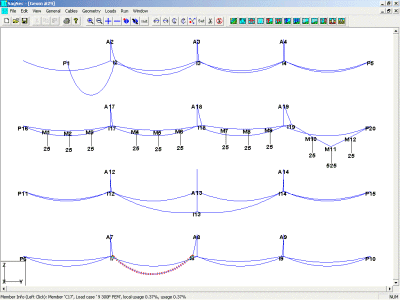SAGSEC
SAGSEC is a powerful and easy to use Microsoft Windows program for the exact nonlinear 3-dimensional static analysis of a multi-span tension section (single ground wire or conductor between two dead-end attachment points). Structural supports for all clamps and insulators can either be fixed or flexible (with specified transverse and longitudinal stiffness). The swings of the insulators as well as their weights and wind areas are accounted for in 3-dimensions. Marker balls can be installed at arbitrary locations along the spans. SAGSEC is commonly used to determine the sags, tensions and support reactions of a tension section when the simplifying concept of "ruling span" is not appropriate. It can calculate the section static equilibrium configuration for arbitrary combinations of: 1) sagging conditions, 2) wind velocity and direction, 3) balanced or unbalanced ice, 4) temperature, 5) broken conductors or insulators, 6) slack redistribution through offsets or other means and 7) support relocations with a fixed length of cable between the dead ends.
SAGSEC is a user friendly program with easy to interpret text and graphics summaries of your analysis. The text reports include detailed analysis results and the graphics displays the equilibrium shape of a single tension section. Our goal with SAGSEC is to make the most streamlined program possible for the sag-tension analysis of a single tension section. This was done by omitting many of the features that would be included in a more complete line design program. Users wanting a more complete set of line design features including terrain modeling, clearances to terrain, rating, structure spotting, material management and plan & profile sheet generation are better served by the standard edition of our PLS-CADD program. PLS-CADD and SAPS also build upon the FE sag-tension capability offered in SAGSEC allowing more sophisticated modeling of structure flexibility and the interaction between wires of different circuits and phases than is possible with the single wire model in SAGSEC.
Ruling Span vs Finite Element Analysis
Traditional ruling span analysis can be in error in cases of changing conductor attachment elevations, in spans that differ in length from the ruling span, and in cases of stiff post insulators. This effect is even more evident in cases of short spans adjacent to long spans and is the reason why many engineers have set adjacent span limitations in their line design criteria. SAGSEC allows users to analyze a section of conductor in a finite element environment that is much more accurate that the traditional ruling span design process.
As utilities choose to operate their lines at hotter temperatures than ever before, this error becomes even more important. The Institute of Electrical and Electronics Engineers (IEEE) has investigated the limitations of ruling span analysis and recommends that some type of finite element analysis be used in cases of extreme operating temperatures (IEEE Transactions on Power Delivery, Vol. 14, No. 2, April 1999). SAGSEC can be used to accurately determine the conductor sags and tension associated with the ever increasing operating temperatures.
Substation Strain-Bus Calculations
SAGSEC allows engineers to perform the previously difficult analysis of strain bus configurations in substations. In short spans, the insulators, particularly porcelain and glass types, can cause unanticipated sags and over-tensioning of conductors, which could be detrimental to the physical design of the span, taps, and associated structures if not properly accounted for. Effects of insulators in short spans, taps, and short-circuit loads can be accurately modeled and resultant sags and tensions be used to properly design the gantry structures.
Summary
SAGSEC provides the capabilities a structural or electrical engineer requires to accurately analyze transmission and substation conductor systems. It does so using a simple easy to use graphical interface that rests upon our time tested finite element engine. If you would like more information about SAGSEC please contact us.
Many clients ask whether SAGSEC or PLS-CADD/LITE is better suited for solving a certain kind of problem. This comparison chart should help you decide which program will best meet your needs.
Summary of Features
A Microsoft Windows 10 or 11 (x64) environment that lets you:
Specialized program for the analysis of a multi-span tension section
Extreme ease of input through interactive menus
Tension section can include line angles and up to 400 spans with unequal end elevations
Post, strain, and suspension insulators can be used at all locations, including line angles
Spans, strain insulators and suspension insulators are modeled as exact 3-d cable elements
Automatic calculation of wind loads on cables, marker balls and insulators
Accounts for the effect of wind direction relative to the spans
Determines sags and loads from arbitrary ice imbalance conditions
Determines Residual Static Loads (RSL) after broken conductors or insulators
Considers the effects of transverse and longitudinal flexibilities of the structure attachment points
Determines the effects of moving a support while total length of cable remains unchanged
Determines the effects of redistributing or changing slack through offset clippings or other means
Concentrated vertical loads (such as weights from broken trees) can be applied at any span location
Determines equilibrium configuration of tension section while in sheaves
Calculates offset clippings for construction in hilly terrain
Imperial or SI (metric) units
Detailed User's Manual with examples
On-line/electronic user's manual linked in to provide context sensitive help
Powerful graphics module (stress usages shown in different colors)





